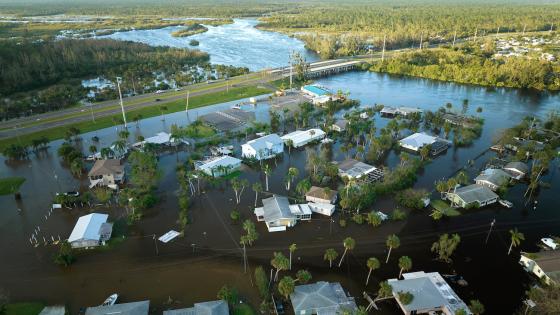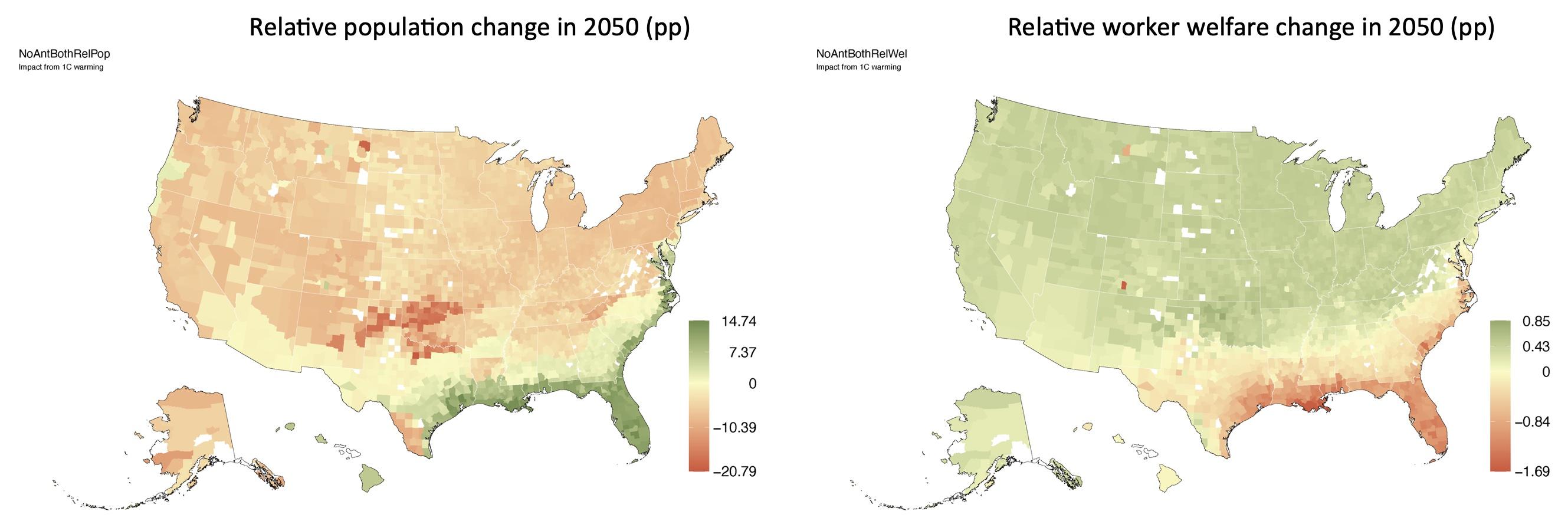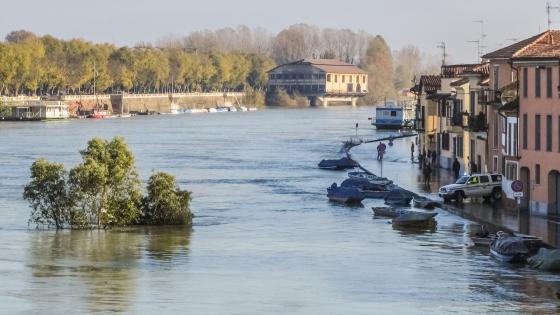We hear about the pernicious effects of climate change constantly. There is a broad consensus among scientists, politicians, journalists, and others that raising awareness about the negative effects of climate change is useful (Weder di Mauro 2021). For instance, it can strengthen support for mitigation policies or preemptive action to avoid the largest damages. Although warning people about the future impact of climate change might seem desirable, little is known about the impact of anticipation on the local and aggregate effects of climate change. In a recent paper (Bilal and Rossi-Hansberg 2023), we propose a novel quantitative framework to evaluate the economic impact of climate change on all US counties. Because our framework features forward-looking migration and investment adaptation responses, agents anticipate climate change and react immediately to future expected changes in climate. We use this framework to gauge the local and aggregate importance of anticipation responses.
To many readers, it might seem surprising that economists do not know more about the local role of anticipatory adaptation responses to climate change. The reason is simple: dynamic general equilibrium models with aggregate climate shocks and many locations are hard to analyse and compute. Consider a person living in Florida, who expects storms and heatwaves to intensify severely close to their home over the next few decades. Should they move elsewhere? And if so, where? Clearly, they need to consider how climate will affect other counties. Furthermore, they need to predict how other people and investors will anticipate these changes and react to them themselves. Naturally, all these reactions affect local economies since they determine how much capital is invested and how many people live there. Our Florida resident faces this complex problem, as do millions of others that live all across the US. Their reactions determine how climate change ultimately impacts all regions. Technically, we are faced with a heterogenous agent dynamic economy with aggregate shocks, where the number of state variables is the stock of capital and population size in each county. For the US economy and its 3,143 counties, this implies more than 6,000 state variables. Solving the transition of this economy in response to climate change has proven intractable so far.
To make progress, we leverage the solution method in Bilal (2023) of a ‘Master equation’ state-space approach to this type of economy. This consists of an analytical first-order (and potentially higher-order) representation of the directional derivatives of policy functions around the steady state. The result is a solution to this complex problem that allows us to solve the evolution of this economy in seconds. With this methodology, we are able not only to compute counterfactual exercises but also to structurally estimate the migration and investment elasticities that govern the responses of people and investments to changes in the economic environment.
An important part of the quantification of economic climate models is to estimate structural ‘damage functions’, namely, to determine how changes in temperatures affect local fundamentals in the model. In our case, we want to study how heatwaves and storms affect local productivity, amenities, and capital depreciation rates. Our starting point is a reduced-form estimation of the effect of heatwaves and storms on local outcomes using an event study design. We use data since 2000 at the county level and estimate the impulse response from these events on population, income per capita, and investments. For storms, for example, we estimate that, in coastal counties, a once-in-50-years storm leads to a 5% decline in county population, a 2.5% decline in income per capita, and a large increase in investment for the first few years that reverts back after about six years. Figure 1 shows our estimates for population and investment. We find no significant effects in inland counties. We also estimate the impact of heatwaves. We find that a once-in-20-years heatwave reduces population and income by 2.5%, although only temporarily, and has a small negative effect on investment in counties with average temperatures above the median. We do not find significant effects in colder counties.
Figure 1 The impact of a once-in-50-years storm in coastal counties
The estimated reduced-form relationships imply that the effect of storms can be well-captured by depreciation shocks in our framework, and the effect of heatwaves by a combination of amenity and productivity shocks. The key variable is investment: it reacts positively to storms (as locations are rebuilt afterwards) but its reaction to heatwaves is negative and small. We also use more than a century of climate data to estimate the effect that changes in global temperatures have on the probability of local storms and heatwaves. We find that, indeed, changes in temperatures have led to a higher probability of storms in coastal counties and heatwaves in counties with temperatures above the median.
We then estimate structural damage functions that match these empirical results. The resulting damage functions imply that increases in temperatures affect capital depreciation rates primarily on the southeast coast of the US because of rising storm activity. Heatwaves affect productivity and amenities across a wider area, but one that is also concentrated in the south and southeast of the US. Figure 3 presents the productivity and capital depreciation rate impact of a 1C increase in global temperatures.
Figure 2 The impact on productivity and capital depreciation of a 1C increase in global temperature
The implied impact of climate change on the economy is about twice as large as in other studies with regional adaptation (e.g. Cruz and Rossi-Hansberg 2021, 2023). The main reason is that we are able to incorporate damages to forward-looking investments and that capital depreciation shocks shrink aggregate investment in capital. Already by 2023, workers’ average welfare losses amount to about 5%, and we find losses larger than 11% by 2100. Capital owners lose a few percentage points more. These results imply an ongoing loss of more than $3,000 in consumption per year from 2023 onwards. This consumption loss may already seem substantial, but residents of specific counties lose much more than this. In coastal Louisiana, climate change reduces the consumption of workers by more than $9,000 per year, and home and business owners that hold capital lose in excess of $15,000 per year.
So, what is the role of anticipation in shaping these results? In the aggregate, not much. Whether individuals anticipate future increases in global temperatures and their effect on heatwaves and storms does not affect the aggregate losses from climate change for workers or capital owners by more than 0.3 percentage points. However, it significantly affects the geography of the US economy and losses in particular regions. For example, without anticipation, the decline in population in parts of Florida is 15 percentage points lower by 2050. People stay there because they do not foresee that storms and heatwaves will become more prevalent and that people and investments will move elsewhere in response. Consistently, people that stay face larger losses. In parts of Florida, Louisiana, South Carolina, and Texas the welfare implications for workers are more than 1.5 percentage points larger by 2050, which amounts to an additional loss of roughly $400. Figure 3 presents the geographic distribution of these effects. Overall, we find that incorporating adaptation and anticipation into climate assessment models is essential to have credible estimates of the local impact of climate change.
Figure 3 Differential effect of climate change eliminating anticipation
References
Bilal, A (2023), “Solving Heterogeneous Agent Models with the Master Equation”, NBER Working Paper 31103.
Bilal, A and E Rossi-Hansberg (2023), “Anticipating Climate Change Across the United States”, CEPR Discussion Paper 18192.
Caliendo, L, M Dvorkin and F Parro (2019), “Trade and Labor Market Dynamics: General Equilibrium Analysis of the China Trade Shock”, Econometrica 87(3): 741-835.
Cruz, J-L and E Rossi-Hansberg (2021), “Unequal gains: Assessing the Aggregate and Spatial Economic Impact of Global Warming”, VoxEU.org, 2 March.
Cruz, J-L and E Rossi-Hansberg (2023), “The Economic Geography of Global Warming”, Review of Economic Studies, forthcoming.
Kleinman, B, E Liu and S J Redding (2023), “Dynamic Spatial General Equilibrium”, Econometrica 91(2): 385-424.
Weder di Mauro, B (2021), “Combating Climate Change: A CEPR Collection”, VoxEU.org, 27 October.






